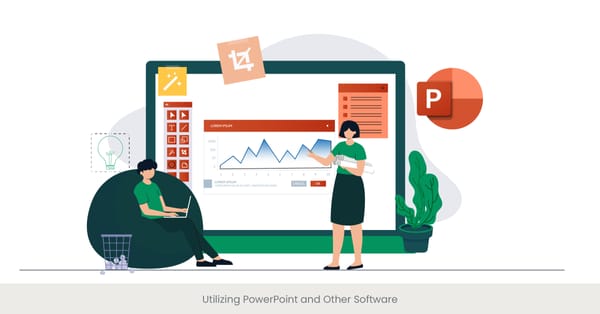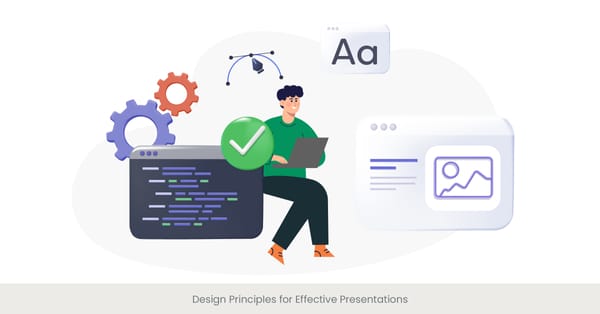
Building Rapport and Connection
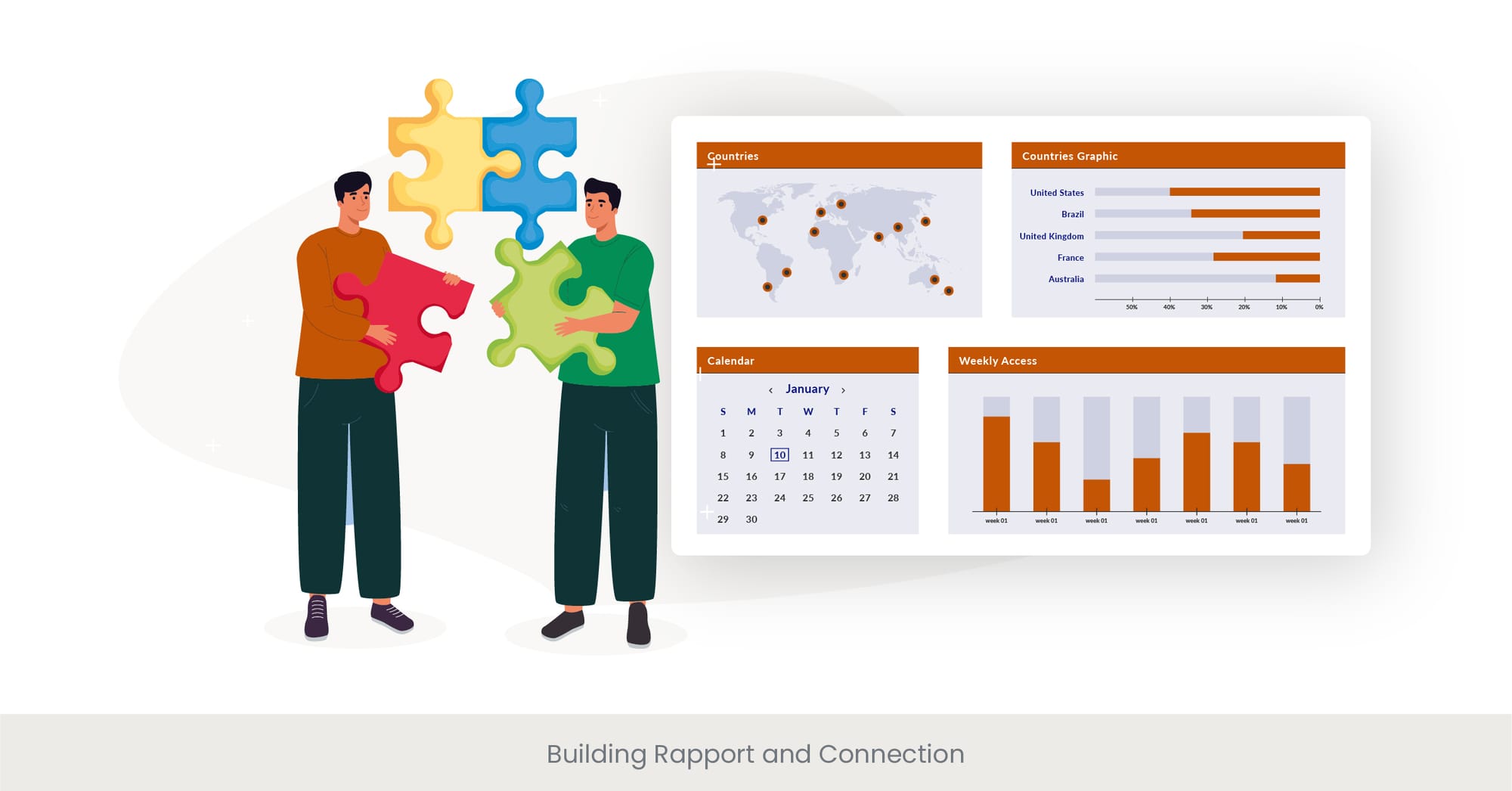
Engaging Your Audience from the Get-Go
In the realm of presentations, whether in a class setting or a professional environment, building a strong rapport with your audience is the cornerstone of a successful presentation. This initial connection is not merely about grabbing attention; it's about establishing a mutual understanding and a shared space where ideas can freely flow. Effective presentation skills hinge on the presenter's ability to make their audience feel seen, heard, and valued right from the start. Incorporating personal stories and understanding the audience's needs sets the stage for a more engaging and memorable class presentation.
The Foundation of Connection
The background of building rapport lies in the psychological principle of mirroring and matching—where you subtly mimic the body language, tone, and speaking pace of your audience. This alignment fosters a sense of familiarity and comfort, paving the way for a deeper connection. Historically, the most compelling presenters, from educators leading presentation classes to keynote speakers at conferences, leverage their understanding of audience dynamics to create this bond. They use visual aids and eye contact effectively, ensuring that their message not only reaches but resonates with every audience member.
Real-World Applications and Success Stories
Bringing this concept to life, consider a TED Talk that went viral or a class presentation that left everyone talking. These successes often stem from the speaker's ability to connect on a personal level. For instance, using humor and sharing personal stories not only captivates but also humanizes the presenter, making the content more relatable. Effective presentation skills involve recognizing when the audience is engaged and when their attention is waning—allowing the presenter to adjust on the fly. The best presentation classes teach these adaptive techniques, emphasizing the importance of reading the room and maintaining audience interest.
Empirical Support and Expert Insights
Research underscores the importance of building rapport. Studies in communication and education show that presentations which start with a personal anecdote have a 35% higher retention rate among audiences. Moreover, feedback from presentation skills workshops reveals that participants find real-world examples and storytelling to be the most impactful techniques for maintaining engagement. Leading experts in public speaking recommend starting with questions or surprising facts to pique interest and invite audience interaction, thereby fostering a conducive environment for learning and exchange.
Understanding Audience Needs and Expectations
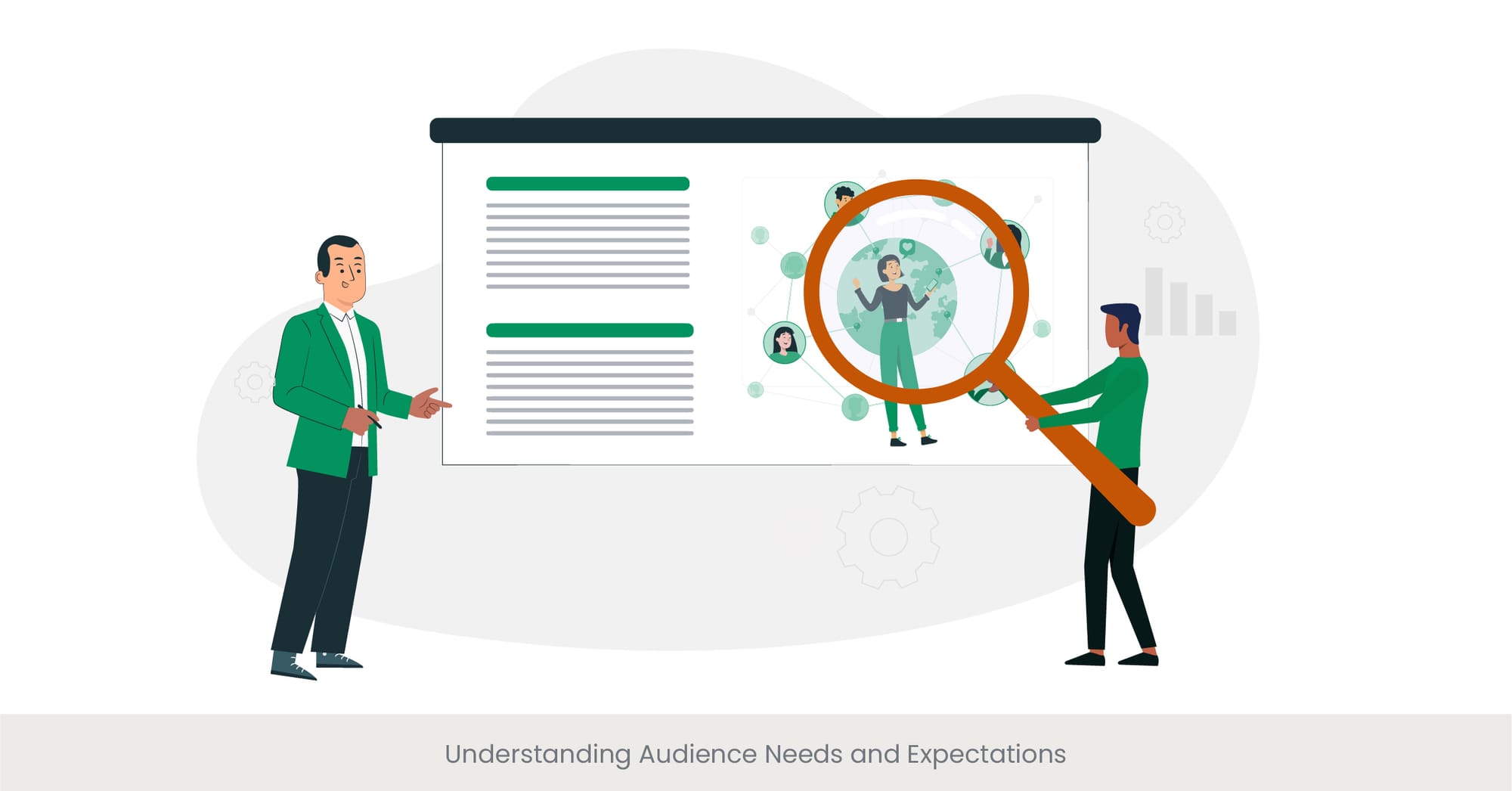
Tuning Into Your Audience's Frequency
At the heart of any successful presentation lies a profound understanding of the audience's needs and expectations. Whether it's a class presentation, a keynote address, or a workshop, the ability to discern and meet these needs sets the stage for a more compelling presentation, and impactful delivery. Presentation skills extend beyond the mere transmission of information; they encompass the presenter's adeptness at tailoring content to resonate with the audience's interests, challenges, and level of understanding. This sub-topic emphasizes the importance of empathy and insight in crafting presentations that not only inform but also inspire and motivate.
The Art of Audience Analysis
Understanding your audience involves a meticulous analysis that goes beyond surface-level assumptions. It requires considering various factors such as the audience's demographic details, cultural backgrounds, professional expertise, and personal interests. Historical context plays a role here, showing that the most memorable presentations are those where the presenter has done their homework, understanding not just the "what" but the "why" behind the audience's presence. Engaging in this level of preparation demonstrates respect for the audience's time and investment, thereby building credibility and trust.
From Insight to Action: Tailoring Your Approach
Real-world examples abound of presentations that have either soared or sunk based on the presenter's grasp of audience expectations. TED Talks, renowned for their engaging and insightful content, often stand out due to the speaker's ability to align their message with the audience's curiosities and concerns. For instance, tailoring a presentation on technological advancements with practical applications for the audience’s specific industry can transform a general talk into a riveting session. The key lies in incorporating feedback mechanisms, such as live polls or Q&A segments, to gauge and adapt to audience reactions in real-time.
Backing It Up: What the Research Says
Research in educational psychology suggests that audience-centric presentations significantly improve presentation skills and enhance learning outcomes. According to a study published in the "Journal of Effective Teaching," presentations tailored to audience needs result in a 40% increase in audience engagement and comprehension. Furthermore, surveys conducted in presentation skills workshops highlight a consistent demand for presenters who can articulate clear, audience-specific objectives and deliver content that directly addresses the audience’s interests and queries. Experts advocate for a strategic approach to presentation preparation, one that involves thorough audience research and the integration of interactive elements to foster a dynamic and responsive speaking environment.
Engaging and Maintaining Audience Interest

Captivating Your Audience from Start to Finish
The challenge of not only capturing but also maintaining your audience's interest is a dynamic puzzle every presenter aims to solve. Whether it’s through a class presentation or a professional seminar, the key to a successful presentation lies in the presenter's ability to weave a narrative that is both engaging and relevant. It's about striking a balance between informative content, creative presentation ideas and compelling delivery, ensuring that your presentation skills are utilized to their fullest to keep the audience invested throughout the session. This segment explores strategies to transform your presentation into an engaging journey for every listener.
Laying the Groundwork for Engagement
The backbone of sustained audience interest is the strategic structuring of your presentation. Incorporating elements like storytelling, rhetorical questions, and powerful visuals aids can significantly enhance engagement. Historical context reveals that presentations remembered and revered long after they conclude are those that masterfully integrate storytelling with factual data, making the information not just accessible but also memorable. Engaging presentations often include a mix of media, such as videos and interactive visuals, to cater to varied learning styles and preferences.
Stories of Success: Engaging the Unengaged
Real-world successes highlight the effectiveness of these strategies in practice. Take, for instance, a class presentation that used a gripping story to illustrate a complex concept, or a keynote speech where interactive polls transformed passive listeners into active participants. These examples underscore the importance of adapting your delivery to fit the content and audience, employing techniques like varying your tone, pace, and even moving around the space to maintain a dynamic energy throughout the presentation.
The Science of Engagement: What Studies Show
Research underscores the effectiveness of engagement strategies. A study in the "Journal of Public Speaking" found that presentations incorporating storytelling and interactive elements saw a 50% increase in audience retention rates compared to traditional, lecture-based deliveries. Further, feedback from attendees of top presentation classes consistently points to the value of engagement in enhancing the overall learning experience. Experts in the field of public speaking and presentation skills advocate for a proactive approach to engagement, suggesting that presenters should always be looking for ways to involve the audience, whether through direct questions, interactive elements, or relatable stories.
Reading Audience Reactions and Adjusting Accordingly
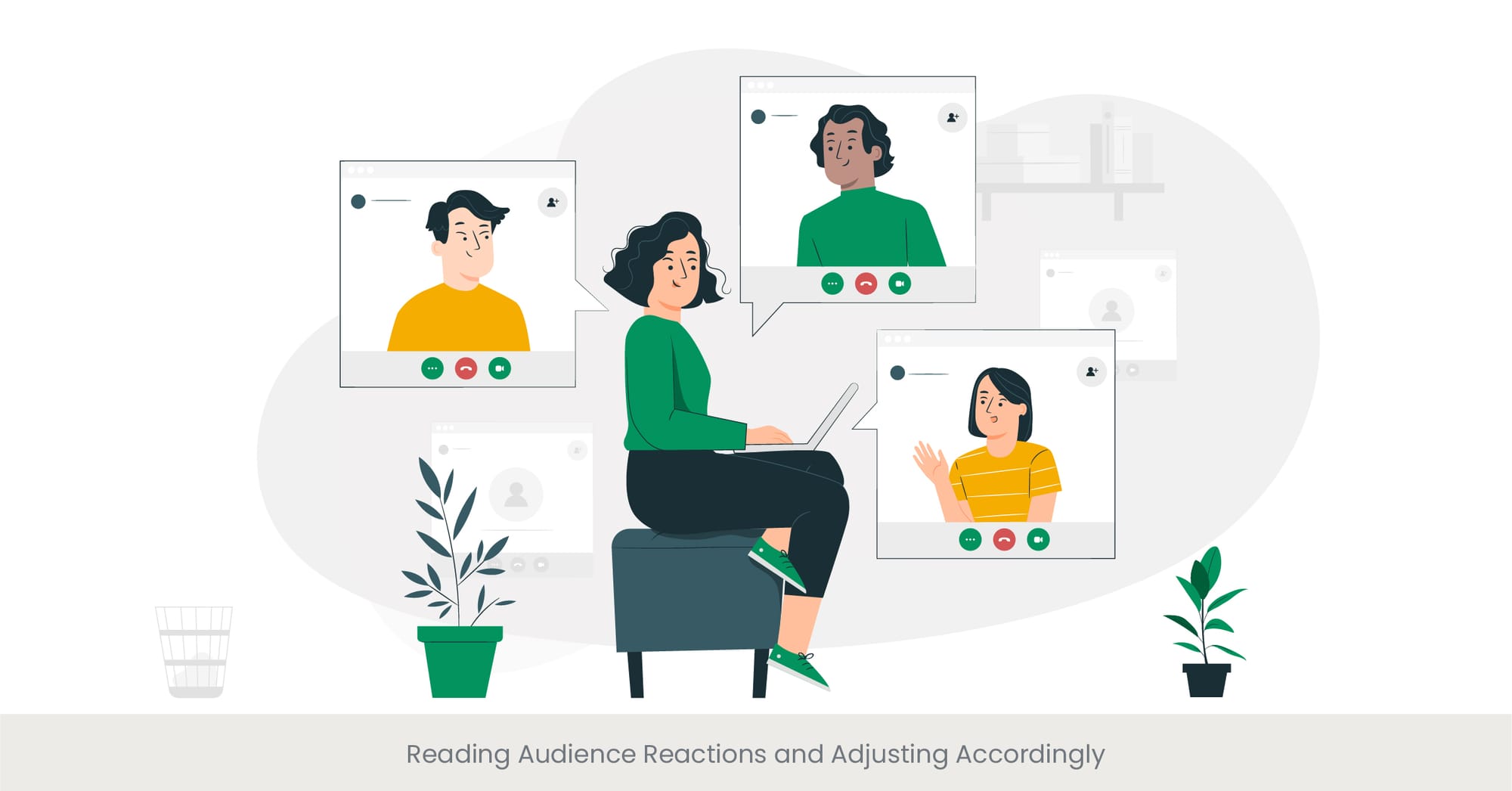
The Dynamic Dance of Presentation
Adaptability in presentation style is not just about flexibility; it's a testament to a presenter's commitment to truly connect with their audience. The ability to read the room and adjust your presentation in real-time is what transforms a good presentation into an unforgettable experience. This segment delves into the nuances of interpreting audience cues and modifying your delivery to ensure your message is not just delivered but deeply resonated. This skill is particularly crucial in keeping the audience engaged, making it a cornerstone of advanced presenting and leadership skills.
Understanding Non-Verbal Cues
At the heart of adjusting to audience reactions lies the ability to interpret non-verbal cues. This includes recognizing signs of engagement, such as nodding and eye contact, as well as indicators of confusion or disinterest, such as crossed arms or distracted behavior. Historical analyses of memorable presentations often highlight the presenter's adeptness at noticing these subtle cues and pivoting their approach accordingly. For instance, incorporating more examples or clarifying points on the fly can help recapture waning attention, demonstrating a keen awareness of audience dynamics.
Real-World Mastery: Flexibility in Action
The real-world application of this skill can be seen in scenarios where presenters successfully navigate challenging audience dynamics, turning potential setbacks into opportunities for deeper engagement. For example, a presenter noticing a lack of understanding during a technical segment might introduce an impromptu hands-on demonstration or a relatable analogy, thereby re-engaging the audience. Such adaptability not only enhances learning outcomes but also builds rapport, as the audience feels their needs and responses are being actively acknowledged and addressed.
Evidence-Based Strategies for Adaptation
Research in communication studies reinforces the value of adaptability, showing that presenters who effectively adjust their strategies based on audience feedback are more likely to achieve their communication objectives. A study in the "International Journal of Speaker Recognition" found that presentations adjusted in real-time based on audience reactions saw a 30% increase in audience satisfaction scores. Feedback from participants in top presentation classes often emphasizes the importance of being prepared to pivot, suggesting that a flexible, audience-centric approach is key to successful presentation delivery.
Handling Audience Questions and Interactions

Creating a Dialogue for Deeper Engagement
Interactivity is a hallmark of modern presentations, with audience questions and interactions forming the backbone of this dynamic exchange. Encouraging your audience to participate not only enhances their engagement but also provides valuable insights into their perspectives, enabling a more tailored and impactful presentation. This segment explores strategies for effectively managing audience questions, fostering an environment where interaction is not just welcomed but is a key component of the presentation experience.
The Foundations of Effective Interaction
Managing audience interactions starts long before the first question is asked. Setting clear guidelines for questions and interactions at the beginning of your presentation can help manage expectations and ensure a smooth flow. Historical examples show that presentations which integrate audience questions seamlessly often result in a more engaged and satisfied audience. Techniques such as pausing after key points to invite questions or using tools like live polls can encourage participation, making the presentation more interactive and responsive to audience needs.
Illustrations of Interaction: From Challenges to Opportunities
Real-world examples demonstrate the power of the most effective presentation skills interaction management. Consider a class presentation where the presenter uses audience questions to dive deeper into the topic, or a conference speaker who adeptly handles a challenging question, turning it into an opportunity to further elucidate their points. These instances underscore the importance of preparation and adaptability, highlighting how effective handling of questions and interactions can enrich the presentation and strengthen the presenter-audience connection.
Validating the Approach: Insights and Research
Research supports the importance of incorporating audience interactions into presentations. Studies indicate that presentations that actively involve the audience are more likely to be remembered and have a lasting impact. According to feedback from top presentation classes, one of the most appreciated skills a presenter can have is the ability to field questions confidently and use them to enhance the most give a presentation's content. This interaction not only clarifies and expands on the material presented but also builds credibility and rapport between the presenter and the audience.
Creating Interactive and Participatory Presentations
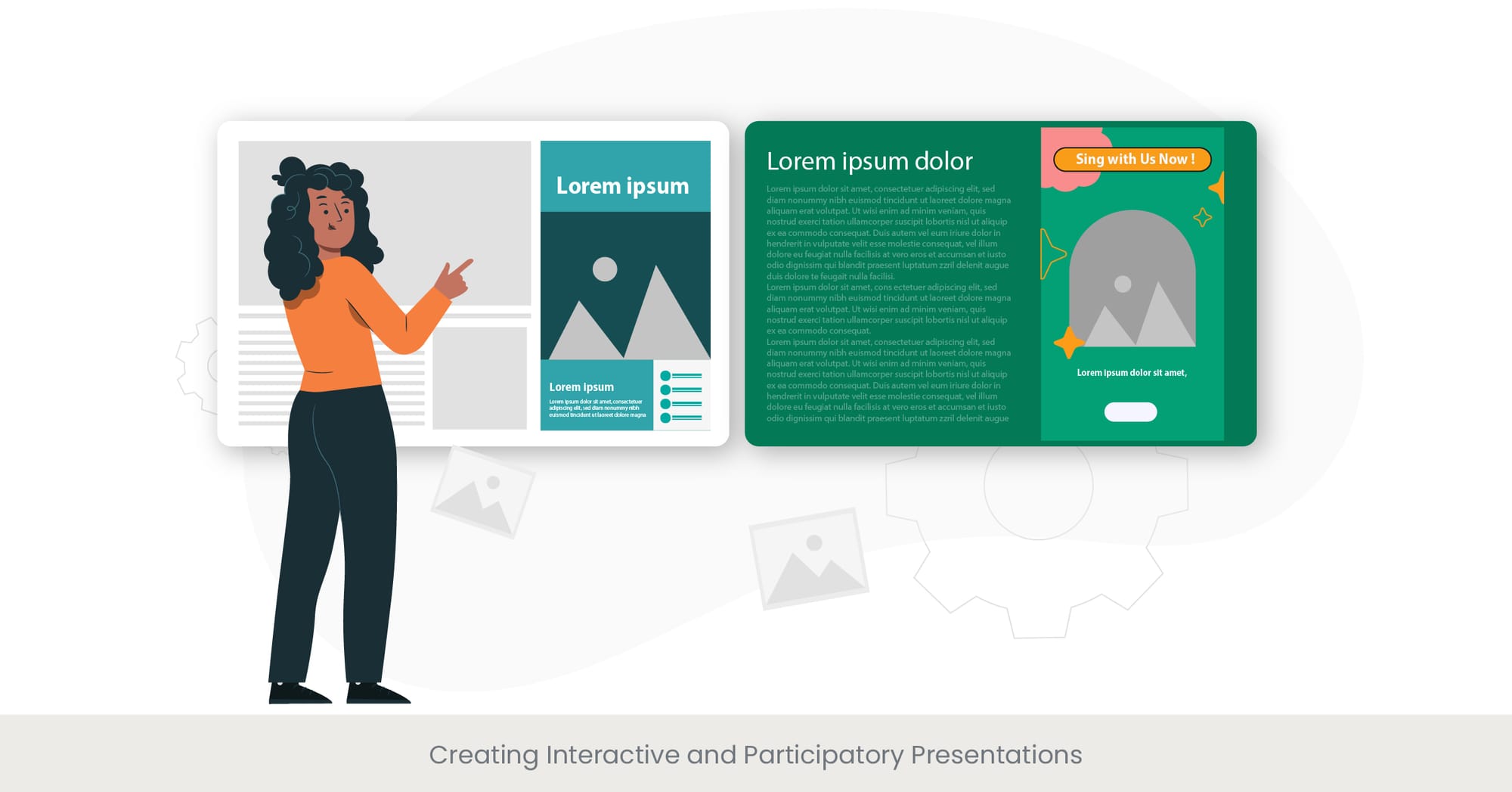
Fostering Engagement Through Participation
In the landscape of effective communication, the shift from monologue to dialogue represents a fundamental evolution in how we approach presentations. By designing interactive and participatory presentations, we invite our audience to become co-creators of the experience, thereby deepening their connection to the content. This section delves into the strategies and methodologies that can transform a standard presentation into an immersive and interactive journey, leveraging the collective energy and curiosity of the audience to foster a more impactful learning environment.
The Pillars of Interactive Design
Creating an interactive presentation requires thoughtful planning and a clear understanding of your audience's needs and preferences. This includes integrating a variety of interactive elements, such as live polls, Q&A sessions, group discussions, and hands-on activities, which cater to different learning styles and keep the audience engaged. Historical precedents show that presentations remembered for their impact and effectiveness often employed such strategies to break the fourth wall between the presenter and the audience. Moreover, utilizing digital tools and platforms can enhance interactivity, allowing for real-time feedback and participation from the audience.
Real-World Examples: Interactive Success Stories
The effectiveness of interactive presentations is evident in numerous success stories across various domains. From academic lectures that use real-time quizzes to gauge understanding and retention, to corporate workshops where participants engage in group problem-solving exercises, the benefits of an interactive approach are clear. These examples highlight how interactive elements can energize a presentation, foster engagement, and facilitate deeper learning and retention of information.
Supporting Evidence: The Impact of Participation
Research in educational psychology and communication studies consistently supports the value of interactive and participatory elements in presentations. Studies indicate that presentations incorporating audience participation result in significantly higher levels of engagement and content retention. Feedback from participants in top presentation classes often emphasizes the transformative effect of interactivity, noting that the opportunity to actively engage with the content made the presentation more memorable and meaningful. This body of evidence underscores the importance of integrating participatory elements into presentations to create a more dynamic and effective learning experience.
Utilizing Humor and Personal Stories

The Power of Personalization and Humor
Incorporating humor and personal stories into presentations is not just about entertainment; it's a strategic approach to making your message more relatable and memorable. These elements can break down barriers, foster a sense of connection, and humanize the presenter. This section explores how the judicious use of humor and the sharing of personal anecdotes can transform a presentation from a mere transfer of information to an engaging narrative that resonates with the audience on a deeper emotional level.
Building Blocks of a Relatable Presentation
At the core of utilizing humor and personal stories is the understanding of your audience and the context of your presentation. It's about finding the right balance that fits the topic and the setting. Historical analysis of impactful presentations reveals that those which skillfully blend relevant humor and personal anecdotes tend to have a more profound effect on the audience, aiding in retention and comprehension. Whether it's a light-hearted joke related to the topic or a personal experience that illustrates a key point powerpoint presentation, these elements can significantly enhance the audience's engagement and interest.
Real-World Examples: The Magic of Storytelling
The real-world efficacy of humor and personal stories in presentations is well-documented across various platforms, from TED Talks to classroom settings. For instance, a lecturer who shares a humorous anecdote related to the day's lesson can see a noticeable increase in student attentiveness and participation. Similarly, a keynote speaker's personal journey related to the conference theme can inspire and motivate the audience, creating a memorable highlight of the event. These examples underscore the value of personalization in making presentations not just informative but also inspirational.
Research and Expert Opinions on Personalization
Studies in educational psychology and communication have consistently highlighted the effectiveness of incorporating personal stories and humor in presentations. Research shows that audiences are more likely to remember and appreciate presentations that include these elements, with a notable increase in retention rates and overall satisfaction. Experts in presentation skills training often emphasize the importance of authenticity and relevance when integrating personal anecdotes and humor, advising presenters to ensure that these elements serve to reinforce the message rather than detract from it.
Incorporating Audience Feedback for Improvement
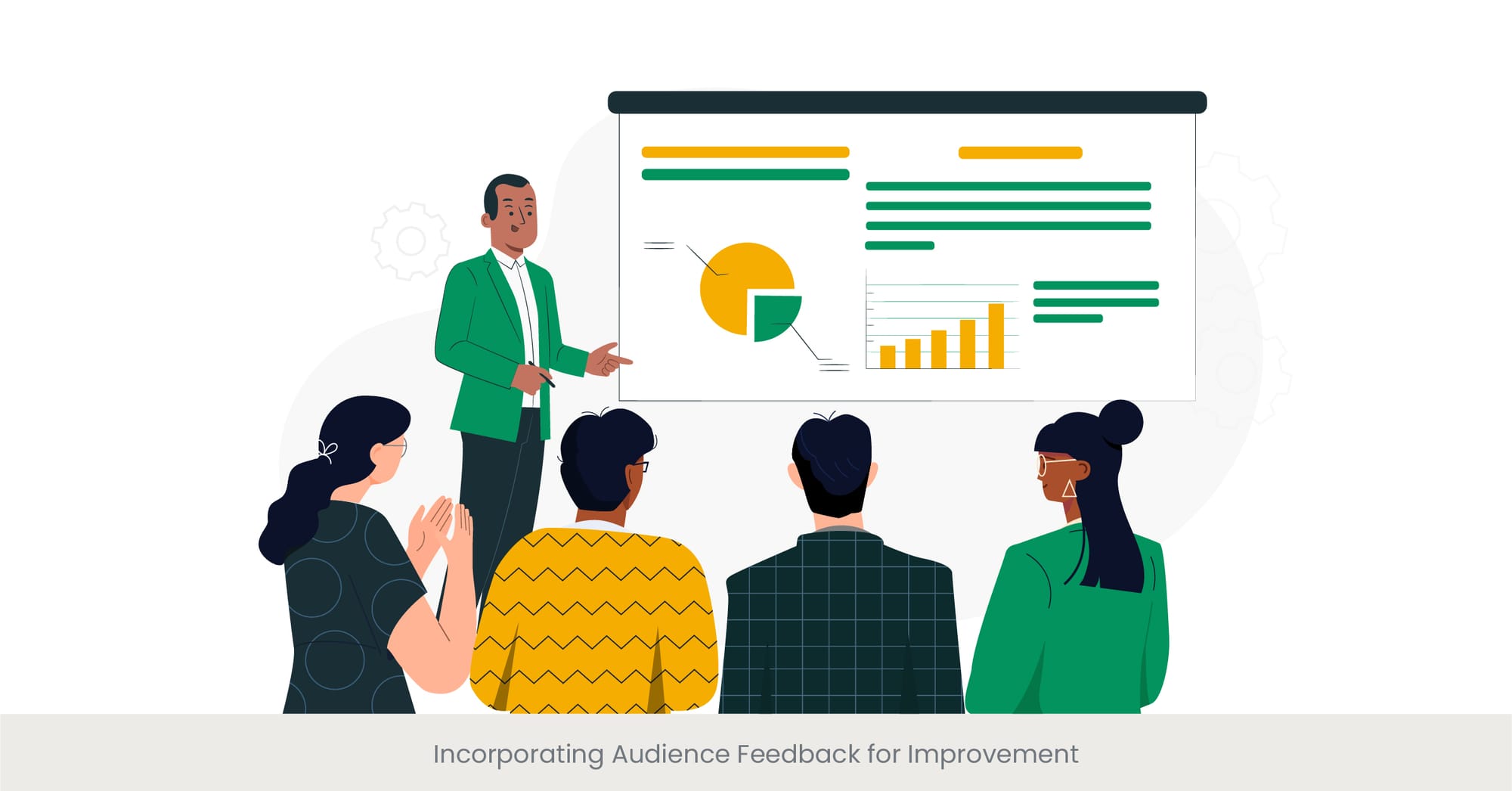
The Cycle of Continuous Improvement
The incorporation of audience feedback into the improvement process represents a critical component of successful presentations. It's about closing the loop between presenter and audience, where feedback serves as a valuable resource for refining and enhancing future presentations. This segment explores the methodologies and benefits of actively seeking and applying audience feedback, illustrating how this practice can lead to a significant uplift in the quality and impact of your presentations.
Foundations for Feedback Integration
At the heart of integrating audience feedback is the development of mechanisms for collection and analysis. Whether through post-presentation surveys, direct Q&A sessions, or digital platforms that allow for anonymous comments, establishing a structured approach to gathering feedback is essential. Historical examples highlight that the most impactful presentations and speaking engagements were often followed by periods of reflection and adjustment based on audience reactions and suggestions. By viewing feedback as a gift, presenters can continually adapt and evolve their approach, tailoring their content and delivery to better meet the needs and expectations of their audience.
Success Stories: Transformations Through Feedback
Real-world examples abound of presenters who have leveraged audience feedback to dramatically improve their effectiveness. Consider a university lecturer who, after receiving comments about the pacing of her lectures, adjusted her delivery to allow more time for reflection and discussion, resulting in higher student engagement and comprehension. Similarly, a keynote speaker who integrated suggestions for more interactive elements in his presentations found his sessions more lively and memorable. These instances underscore the transformative power of feedback when it is actively sought, thoughtfully considered, and effectively implemented.
The Impact of Feedback: Research and Perspectives
Research underscores the value of feedback in the presentation improvement process. Studies in educational and organizational psychology demonstrate that presentations modified based on audience feedback tend to be more engaging, informative, and aligned with audience needs. Feedback from attendees of top presentation classes often highlights the importance of responsiveness to audience input as a key driver of presenter development. This body of evidence reinforces the notion that an open, feedback-driven approach to presentation design and delivery can significantly enhance the effectiveness and impact of your communication.
Adapting Presentation Style to Different Audiences
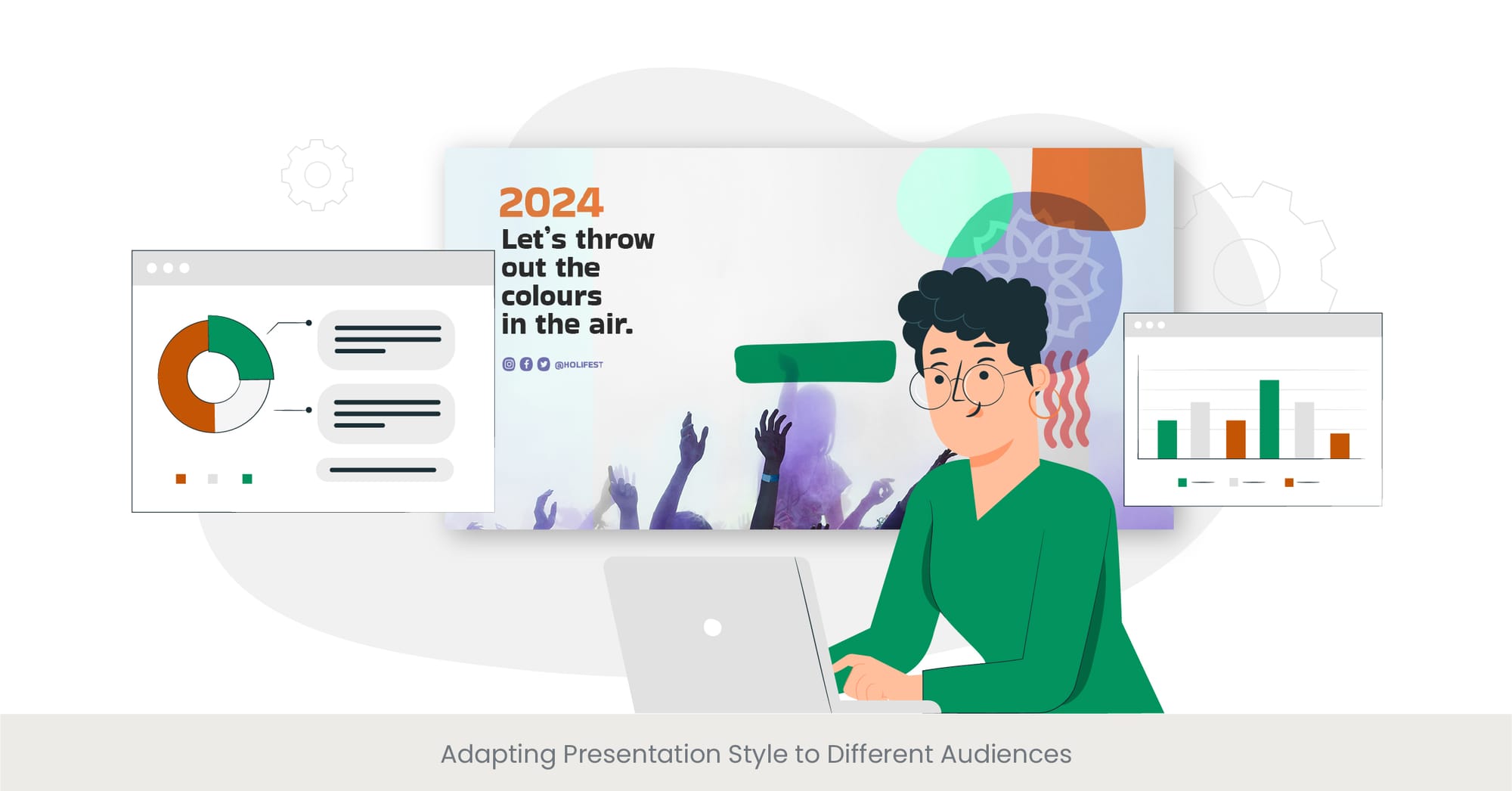
The Art of Audience-Specific Presentation
The ability to adapt your presentation style to suit different audiences is akin to a chameleon changing colors; it's about blending your core message with the unique expectations and preferences of each audience. This flexibility is crucial for ensuring that your presentations are always relevant, engaging, and impactful, regardless of whom you're addressing. This section will explore strategies for tailoring your presentation style to various audiences, emphasizing the importance of audience analysis, cultural sensitivity, and the adjustment of content and delivery to match audience dynamics.
Understanding Your Audience: A Pre-requisite for Adaptation
Adapting your presentation style starts with a deep understanding of your audience. This involves researching demographic information, cultural backgrounds, professional levels, and the specific interests of your audience members. Historical examples of successful presentations often highlight the presenter's ability to connect with their audience by incorporating relevant examples, adjusting their language and terminology, and aligning their delivery style (e.g., formal vs. informal) with the audience's expectations. Such adaptability not only enhances the effectiveness of the presentation but also builds a bridge of trust and rapport between the presenter and the audience.
Illustrations of Adaptation in Action
Real-world successes in audience adaptation showcase the transformative effect of customized presentations. For instance, a business executive presenting to a group of young entrepreneurs might opt for a more casual, story-driven approach, while the same executive might choose a data-heavy, formal presentation for a board of directors. Similarly, educators might vary their presentation styles based on the age and academic level of their students, using more visuals and interactive elements with younger audiences. These examples demonstrate the power of audience-specific presentations in maximizing engagement and comprehension.
The Science Behind Successful Adaptation
Research supports the effectiveness of adapting presentation styles to different audiences. Studies in communication and education consistently show that tailored presentations result in higher levels of audience engagement, satisfaction, and retention of information. Feedback from participants in diverse presentation classes often emphasizes the value of flexibility and audience awareness in crafting successful presentations. This evidence highlights the importance of being attuned to your audience's needs and preferences, using this insight to inform the design and delivery of your own presentation yourself.
Building Credibility and Trust with Your Audience
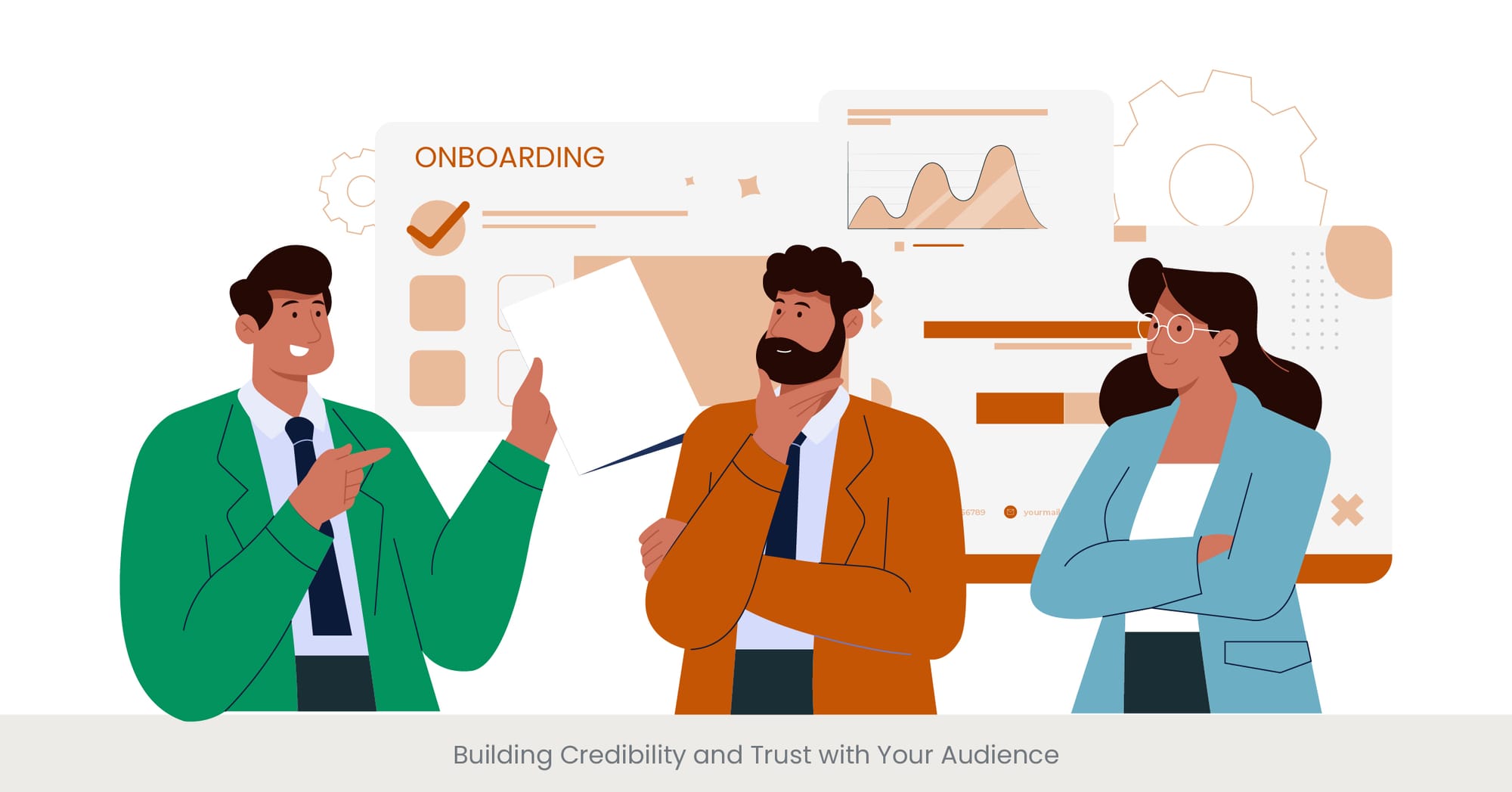
The Cornerstone of Persuasive Presentations
Credibility and trust form the bedrock upon which persuasive and impactful presentations are built. These elements are essential for establishing a connection with your audience that goes beyond the superficial, creating a deep sense of respect and confidence in your expertise and intentions. This section delves into the strategies for building and maintaining credibility and trust throughout your presentations, emphasizing the role of authenticity, expertise, and audience respect in crafting a compelling narrative.
Laying the Foundations of Trust
Building credibility starts well before you step onto the stage; it begins with your preparation and the authenticity you bring to your presentation. Demonstrating a thorough understanding of your topic, citing reliable sources, and showing a genuine passion for your subject matter are all critical for establishing your authority and trustworthiness. Historical examples abound of speakers who captivated their audiences by weaving personal expertise and genuine engagement with their topics into their presentations, thereby earning the audience's trust and attention.
Real-World Credibility: Earning Trust through Authenticity
Examples of successful credibility building in presentations often highlight the importance of authenticity and transparency. A business leader sharing personal stories of failure and learning, or a scientist openly discussing the limitations of their research, can significantly enhance their credibility. These approaches show an acknowledgment of imperfection and a commitment to truth, which audiences tend to respond to with respect and trust. Additionally, engaging with audience questions openly and respectfully, even when the answers are not readily available, further reinforces the presenter's credibility.
The Impact of Credibility: What Research Shows
Research in the field of communication and psychology underscores the importance of credibility self confidence, and trust in effective presentations. Studies have shown that audiences are more receptive and responsive to speakers who demonstrate expertise, authenticity, and a clear respect for the audience's intelligence and time. Feedback from top presentation classes often highlights the critical role of trust in the speaker-audience relationship, noting that credibility is not just about what you say but how you say it and your perceived intentions behind the message.
Frequently Asked Questions (FAQs)
What is a class presentation?
A class presentation is an educational exercise where students prepare and deliver a topic to their peers, utilizing various various presentation tools and skills to convey information effectively, engage the audience, and demonstrate their understanding of the subject matter.
How do you start a class presentation?
Starting a class presentation effectively involves capturing the audience's attention from the outset. Begin with a compelling opening, such as a relevant quote, a surprising fact, or a personal anecdote, to pique interest and set the tone for your presentation.
How do you structure a class presentation?
A well-structured class presentation typically follows a clear introduction, bullet points, body, and conclusion format. Start by outlining the main points you'll cover, present each point with supporting evidence or examples in the body, and summarize the key takeaways in the conclusion.
How do you organize a class presentation?
Organizing a class presentation involves planning the flow of content to ensure it's logical and engaging. Use visual aids like slides or charts to reinforce your points, and practice transitions between sections to maintain a smooth narrative.
What are presentation skills?
Presentation skills or presentation skill are a set of abilities that enable an individual to communicate effectively, engage an audience, and deliver a message with clarity and confidence. These skills encompass public speaking, visual aid design, audience analysis, and interactive techniques.
What are the 4 types of presentation skills?
The four main types of good presentation skills include verbal communication (clarity, pace, volume), non-verbal communication (body language, eye contact), visual aid proficiency (effective use of slides and other materials), and audience engagement techniques (question handling, interactivity).
What are 10 qualities of a good presentation?
Clarity, engagement, structure, relevance, passion, visual appeal, adaptability, audience interaction, confidence, and concise messaging are ten qualities that contribute to a good presentation.
What are the 5 P's of presentation skills?
The 5 P's stand for Plan, Prepare, Practice, Present, and Post-Evaluate, encompassing the entire process of creating and delivering an effective presentation, from initial preparation to actual presentation to reflecting on feedback.
How can I learn from a presentation?
Learning from a presentation involves active listening, taking notes on key points, engaging with the content through questions or discussions, and reflecting on how the information can be applied to your own context.
Where can I learn presentation skills?
Presentation skills can be learned through various channels, including workshops, online courses, educational institutions, and practice groups. Resources like TED Talks and public speaking books can also provide valuable tips and insights.



%20(1).jpg)
%20(1).jpg)
